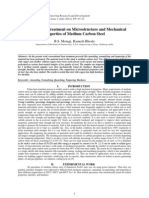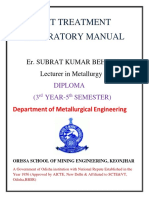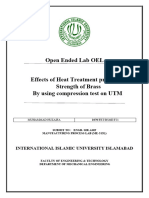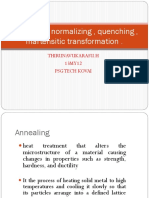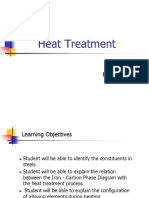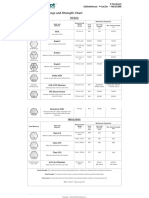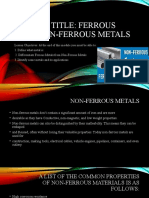Artic B
Artic B
Uploaded by
JoelCasasCopyright:
Available Formats
Artic B
Artic B
Uploaded by
JoelCasasOriginal Title
Copyright
Available Formats
Share this document
Did you find this document useful?
Is this content inappropriate?
Copyright:
Available Formats
Artic B
Artic B
Uploaded by
JoelCasasCopyright:
Available Formats
Citation: Hasan MF (2016) Analysis of Mechanical Behavior and Microstructural Characteristics Change of ASTM A-36 Steel Applying Various
Heat
Treatment. J Material Sci Eng 5: 227. doi:10.4172/2169-0022.1000227
Page 2 of 6
also help to improve machining effect, and make them versatile. They Materials and Methods
are found in applications such as train railroads, beams for building
support structures, reinforcing rods in concrete, ship construction, Sample of ASTM A-36 mild steel was purchased from a local
tubes for boilers in power generating plants, oil and gas pipelines, car market located in Khulna, Bangladesh. All specimens of mild steel of
radiators, cutting tools etc. [3]. The mild steel or called low carbon steel dimensions 8 × 8 × 8 mm was cut using power hacksaw. The chemical
as the main component to through the process of the heat treatment composition of the mild steel sample was determined as given in Table
where it containing several characteristic. The general range of mild 1. Standard tensile and impact specimens were made from ASTM
steel is 0.05% to 0.35%. Mild steel is a very versatile and useful material. A-36 mild steel sample using lathe machine. Samples were subjected
It can be machined and worked into complex shapes has low cost to different heat treatment: annealing, normalizing, hardening, and
and good mechanical properties. It is forms the vast bulk of the steels tempering in accordance to ASM International Standards [7]. Heat
employed for general structural fabrication, sheet metal and so on. treated specimens were tested for mechanical properties. The heat
Bolts and studs are supposed to be made from mild steel (up to 0.25% treatment conditions are listed in Table 2. Four specimens were
carbon) with characteristic toughness and ductility. prepared for each heat treatment type.
Various Microstructures Material composition
The chemical composition of ASTM A-36 steel shown in Table 1.
Prediction of microstructure transformations is prerequisite for
successful prediction of mechanical properties after a heat treatment Working steps
and of generation of stresses and strains during a heat treatment. Phase
transformation modeling is one of the main challenges in modeling of The following steps were carried out in our experimental
heat treatment [4]. During annealing, softening processes are under way investigation:
in the microstructure and, in some cases, recovery and recrystallization I. Samples of ASTM A36 steel were prepared for mechanical
take place as well. Naturally, the morphology of carbides changes as
properties test.
well [5].
II. After that the following specimens were heat treated in the
Ferrite furnace for reaching the austenization temperature (850-900°C) of the
It is α-iron (B.C.C.) having not more than 0.025% carbon in solid following specimens.
solution. It is major constituent in low carbon steels and wrought iron.
III. Then the specific heat treatment operation like hardening,
Its hardness varies from 50 to 100 B.H.N. Its upper tensile strength is
annealing and normalizing had been done.
about 330 MN/m2 and percentage elongation about 40. It can be easily
cold worked [6]. IV. For specific heat treated specimen, the change of mechanical
properties was determined in the following (2.1) using appropriate
Cementite
methods.
It is iron carbide, with 6.67% carbon. Its upper tensile strength is
about 45 MN/m2 and hardness about 650 B.H.N. It is white in color V. Metallographic tests were carried out to observe the changes in
and is brittle. It occurs in steels which have been cooled slowly. It is microstructures after heat treatment.
magnetic below 250°C. In steels containing carbon less than 0.8% it For annealing: In this case the specimen was put in the furnace for
is present as a component of another constituent, “pearlite”. In steels 910°C and we kept it in this situation for approximately 70 minutes.
containing more than 0.8% carbon it exists as a grain boundary film After that it was cooled in a heap of ashes so that it was cooled down at
[6]. a very slow rate.
Pearlite For hardening: In this case the specimen was put in the furnace for
In its microstructure it consists of alternate laminations of ferrite 910°C and we kept it in this situation for approximately 30 minutes.
and cementite. It contains about 0.8% carbon in iron. It is the strongest After that it was cooled in water so that it was cooled down very quickly.
constituent of steel. Its hardness is about 180 B.H.N., ultimate tensile
For normalizing: In this case the specimen was put in the furnace
strength about 920 MN/m2 and percentage elongation about 5% [6].
for 910°C and we kept it in this situation for approximately 70 minutes.
Austenite After that it was cooled in room temperature (Air).
It is a solid solution of carbon in ý-iron (F.C.C.) containing a For tempering: In this case the specimen was put in the furnace
maximum of 2% carbon at 1130°C. It is tough and non-magnetic. It for 450°C and we kept it in this situation for approximately 70 minutes.
exists in plain carbon steels above upper critical temperature. Elements After that it was cooled in room temperature (Air).
like chromium and manganese in steel preserve all or some of austenite
down to 0°C. Austenite consists of polyhedral grains showing twins [6]. Iron family C% Si % Mn % S% P% Fe % Cu%
Mild steel 0.29 0.28 0.10 0.10 0.04 98.14 0.2
Martensite
Table 1: Chemical composition of mild steel.
In plain carbon steel it is obtained by quenching from above upper
critical temperature. It is the hardest constituent obtained in given Condition Annealed Normalized Hardened Tempered
steel. It shows a fine needle-like microstructure. Its hardness is about Temperature, °C 910 910 910 450
700 B.H.N. It is unstable and disappears on reheating the steel. It is Holding time, min 70 70 30 70
magnetic and less tough than austenite. It is considered to be highly Cooling medium Ash Air Water Air
stressed α-iron supersaturated with carbon [6]. Table 2: Summary of heat treatment process.
J Material Sci Eng
ISSN: 2169-0022 JME, an open access journal Volume 5 • Issue 2 • 1000227
You might also like
- MA2024 Final Cheat SheetDocument2 pagesMA2024 Final Cheat Sheetgk231513No ratings yet
- Heat Treatment Lab ReportDocument7 pagesHeat Treatment Lab Reportmuvhulawa bologo100% (1)
- IJETR021548Document3 pagesIJETR021548erpublicationNo ratings yet
- Heat Treatment of ForgingsDocument16 pagesHeat Treatment of Forgingsknightbig66No ratings yet
- Effect of Heat Treatment On Microstructures and Mechanical Prop of Spring SteelDocument7 pagesEffect of Heat Treatment On Microstructures and Mechanical Prop of Spring SteelMahmood KhanNo ratings yet
- Sample 1020Document8 pagesSample 1020Shahroz QureshiNo ratings yet
- Heat TreatmentDocument59 pagesHeat TreatmentINSTECH Consulting100% (2)
- Wear Behavior of 100cr6-PolatDocument6 pagesWear Behavior of 100cr6-PolatAntonioNo ratings yet
- A Case Study of Heat Treatment On Mechanical Properties and Microstructure of C1040 SteelDocument5 pagesA Case Study of Heat Treatment On Mechanical Properties and Microstructure of C1040 SteelShafayat HossainNo ratings yet
- Heat Treatment ProcessDocument46 pagesHeat Treatment ProcessMallappa KomarNo ratings yet
- IJERD (WWW - Ijerd.com) International Journal of Engineering Research and DevelopmentDocument7 pagesIJERD (WWW - Ijerd.com) International Journal of Engineering Research and DevelopmentIJERDNo ratings yet
- Heat Treatment of SteelDocument59 pagesHeat Treatment of SteelNaman ShethNo ratings yet
- Metallurgy Dept Lab ManualSUBRAT KU. BEHERADocument25 pagesMetallurgy Dept Lab ManualSUBRAT KU. BEHERARohitNo ratings yet
- Engg Metallurgy Lecture 5Document54 pagesEngg Metallurgy Lecture 5Patil Sudheer GowdNo ratings yet
- HeattreatmentDocument29 pagesHeattreatmentUJJWAL PRAKASHNo ratings yet
- Heat Treatment ProcessDocument56 pagesHeat Treatment Processkanti Rathod100% (4)
- rohini_82463510230Document26 pagesrohini_82463510230nirmalyade06No ratings yet
- Effects of Heat Treatment Process On Strength of Brass by Using Compression Test On UTMDocument10 pagesEffects of Heat Treatment Process On Strength of Brass by Using Compression Test On UTMMuhammad Huzaifa 1070-FET/BSME/F21No ratings yet
- Dual PhaseDocument3 pagesDual Phaseahmed ezwaiNo ratings yet
- Heat Treatment: Prepared by Approved byDocument20 pagesHeat Treatment: Prepared by Approved byBhanu Pratap ChoudhuryNo ratings yet
- NormalizingDocument4 pagesNormalizingAbd.ul.RahmanNo ratings yet
- Effect of Tempering Temperature On MechaDocument3 pagesEffect of Tempering Temperature On Mechadhani bux jamaliNo ratings yet
- Heat Treatment Report FinalDocument13 pagesHeat Treatment Report FinalEslam MohamedNo ratings yet
- Heat Treatment: Dr. Mohamed Abd Elmonem DahaDocument23 pagesHeat Treatment: Dr. Mohamed Abd Elmonem DahashoroukNo ratings yet
- Surface Hardness Behaviour of Heat Treated Ni-Cr-Mo Alloys: V.K.MuruganDocument6 pagesSurface Hardness Behaviour of Heat Treated Ni-Cr-Mo Alloys: V.K.MuruganJai Prakash ReddyNo ratings yet
- MSM GTU Study Material E-Notes Unit-6 23112020052928AMDocument23 pagesMSM GTU Study Material E-Notes Unit-6 23112020052928AMyashkpatel71No ratings yet
- Heat Treatment Study On Carbon SteelDocument6 pagesHeat Treatment Study On Carbon SteelramaNo ratings yet
- Matreial Lab PDFDocument14 pagesMatreial Lab PDFNedaa AbboushiNo ratings yet
- Ades ProjectDocument15 pagesAdes ProjectOlawale CharlesNo ratings yet
- Heat TreatmentDocument8 pagesHeat TreatmentBaizura Mohd ZanNo ratings yet
- Heat Treatment of Ferrous AlloysDocument11 pagesHeat Treatment of Ferrous AlloysSyed Mohsin Ali Naqvi100% (2)
- Javaheri 2018Document28 pagesJavaheri 2018SOUADNo ratings yet
- Anealing TypesDocument29 pagesAnealing TypesPratheep AddrinNo ratings yet
- ICMIEE-PI-140160Document4 pagesICMIEE-PI-140160RichardNo ratings yet
- BG2802 Heat Treatment and Mechanical Properties of SteelsDocument11 pagesBG2802 Heat Treatment and Mechanical Properties of SteelsVenus LimNo ratings yet
- Engineering Metallurgy Chapter-8 Ref: Introduction To Physical MetallurgyDocument34 pagesEngineering Metallurgy Chapter-8 Ref: Introduction To Physical MetallurgyMD Al-AminNo ratings yet
- 191 197htunDocument8 pages191 197htunkota narendraNo ratings yet
- Lecture Heat TreatmentDocument23 pagesLecture Heat TreatmentabinmwangiNo ratings yet
- Conference PaperDocument6 pagesConference PaperSreekumar RajendrababuNo ratings yet
- Write The Various Classification of Engineering MaterialsDocument7 pagesWrite The Various Classification of Engineering Materialsashok pradhanNo ratings yet
- Metals 11 01121Document18 pagesMetals 11 01121Izod GetterNo ratings yet
- 10 Effect ofDocument6 pages10 Effect ofMada PerwiraNo ratings yet
- Heat Treatment of Steel With Phase DiagramsDocument10 pagesHeat Treatment of Steel With Phase DiagramssrpyrhlNo ratings yet
- Elective punjabi Treatment of SteelsDocument6 pagesElective punjabi Treatment of SteelsmehraisabbNo ratings yet
- 18-6 Theoretical PartsDocument11 pages18-6 Theoretical Partshayder1920No ratings yet
- Ismail 2016 IOP Conf. Ser. Mater. Sci. Eng. 114 012108Document10 pagesIsmail 2016 IOP Conf. Ser. Mater. Sci. Eng. 114 012108Paviter SinghNo ratings yet
- Lab 1 Final'Document7 pagesLab 1 Final'anandohalder12No ratings yet
- Applying Computer Simulation in Improving Heat Treating Condition of Thin High-Carbon Steel PartsDocument5 pagesApplying Computer Simulation in Improving Heat Treating Condition of Thin High-Carbon Steel PartssathishelakkiyaNo ratings yet
- Discussion: Ferrous Alloys Specimen 1 (X17)Document6 pagesDiscussion: Ferrous Alloys Specimen 1 (X17)Starscream Aisyah100% (1)
- Literature ReviewDocument23 pagesLiterature ReviewRISHAVNo ratings yet
- Bainite in SteelDocument12 pagesBainite in Steelsathyadevi konnurNo ratings yet
- Lab PHY 2Document16 pagesLab PHY 2Shivraj ChouguleNo ratings yet
- Effect of Heat Treatment On The Fracture Toughness of AISI 4140 SteelDocument6 pagesEffect of Heat Treatment On The Fracture Toughness of AISI 4140 Steelou82muchNo ratings yet
- Annealing, Normalizing, Quenching, Martensitic TransformationDocument22 pagesAnnealing, Normalizing, Quenching, Martensitic TransformationAboo BackerNo ratings yet
- Heat Treatment: ME 318 Manufacturing TechniquesDocument12 pagesHeat Treatment: ME 318 Manufacturing Techniquesmayur_mechNo ratings yet
- TempleDocument17 pagesTemplesan moedanoNo ratings yet
- Chapter 8 - Heat TreatmentDocument20 pagesChapter 8 - Heat TreatmentISANo ratings yet
- Heat Treatment: Workshop Technology MME 1103Document12 pagesHeat Treatment: Workshop Technology MME 1103Murad Mahmoud Al-hidmi100% (1)
- The Working of Steel Annealing, Heat Treating and Hardening of Carbon and Alloy SteelFrom EverandThe Working of Steel Annealing, Heat Treating and Hardening of Carbon and Alloy SteelRating: 5 out of 5 stars5/5 (4)
- 01 - Different Types of Metal Joining ProcessesDocument44 pages01 - Different Types of Metal Joining ProcessesMetwally NaserNo ratings yet
- Spare List For Boiler Bend Tubes Sl. No. Description of Materials Contract No. Make Drg. No./Part No./BHEL Ref No. Quantity Required Unit RemarksDocument3 pagesSpare List For Boiler Bend Tubes Sl. No. Description of Materials Contract No. Make Drg. No./Part No./BHEL Ref No. Quantity Required Unit RemarksJoydev GangulyNo ratings yet
- Cast Iron Basic Training and ApplicatonsDocument34 pagesCast Iron Basic Training and ApplicatonsKeerthivasan NNo ratings yet
- Iso AnnealingDocument2 pagesIso AnnealingPurushottam Sutar100% (1)
- What Material Would You Use To Make This Bulkhead/firewall?Document2 pagesWhat Material Would You Use To Make This Bulkhead/firewall?Sergio Guevara80% (5)
- Medium Carbon Steel: Nearest StandardDocument2 pagesMedium Carbon Steel: Nearest StandardMouna KallelNo ratings yet
- Pământurile Rare - O Nouă Provocare În Economia Mondială: Cristina BumbacDocument33 pagesPământurile Rare - O Nouă Provocare În Economia Mondială: Cristina BumbacAndrei OctavianNo ratings yet
- Answer:: Tugas 3 DiffusionDocument5 pagesAnswer:: Tugas 3 DiffusionOkky HeljaNo ratings yet
- Lect 9Document21 pagesLect 9e22mecu0009100% (1)
- AMM 2021 2 32 KonstantyDocument7 pagesAMM 2021 2 32 KonstantyKhánh TrầnNo ratings yet
- BSK 46 & Other Grade Material SpecificationDocument6 pagesBSK 46 & Other Grade Material Specification4alamz100% (1)
- SA-522 - ASME BPVC 2021 Sección II Part A-2Document6 pagesSA-522 - ASME BPVC 2021 Sección II Part A-2Mohammad TaherNo ratings yet
- M2-Materials TechnologyDocument81 pagesM2-Materials Technologynr satiraNo ratings yet
- Test 2 Metal With AnswerDocument5 pagesTest 2 Metal With AnswerIsaacNo ratings yet
- Lec1 - Fundamentals of Metal FormingDocument40 pagesLec1 - Fundamentals of Metal Formingthisidisforfun03No ratings yet
- Bolt Depot - Bolt Grade Markings and Strength ChartDocument2 pagesBolt Depot - Bolt Grade Markings and Strength ChartSandeep SNo ratings yet
- A Guide To Etching Specialty Alloys For Microstructural EvaluationDocument11 pagesA Guide To Etching Specialty Alloys For Microstructural EvaluationNecdet KaragülleNo ratings yet
- List of Electrodes - SS and Nickel AlloyDocument3 pagesList of Electrodes - SS and Nickel Alloykvmoorthi100% (1)
- HC28Document1 pageHC28Move NowNo ratings yet
- Ssab Astm A537 C2Document2 pagesSsab Astm A537 C2vasotermiNo ratings yet
- Issuer & Norm Modality / Abbreviation Metal Coat Thickness in MDocument10 pagesIssuer & Norm Modality / Abbreviation Metal Coat Thickness in MBartek HajaNo ratings yet
- Corrosion - Module 4Document23 pagesCorrosion - Module 4Akash SavaliyaNo ratings yet
- Research Proposal HDocument13 pagesResearch Proposal HzahidNo ratings yet
- Chemical MachiningDocument26 pagesChemical MachiningKAMALJEET SINGHNo ratings yet
- Thiosulfate Leaching of Au, Ag and PD From A High SN, PB and SB Bearing Decopperized Anode SlimeDocument10 pagesThiosulfate Leaching of Au, Ag and PD From A High SN, PB and SB Bearing Decopperized Anode SlimeGABRIEL CISNEROS FLORESNo ratings yet
- Report Sa Group 3 Sa Materials Science ECE 069Document17 pagesReport Sa Group 3 Sa Materials Science ECE 069James Laroda LaceaNo ratings yet
- Inv Cat08Document67 pagesInv Cat08Juan Perez PerezNo ratings yet
- 2.6 RedoxDocument41 pages2.6 RedoxSWNCYANIDANo ratings yet
- Amethyst ResearchDocument4 pagesAmethyst ResearchZaphire W. ValenciaNo ratings yet










